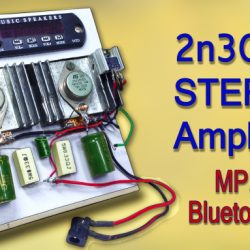
Introduction
Parametric tone control circuits are widely used in audio systems to manipulate the frequency response of audio signals. These circuits allow users to adjust specific frequency ranges, providing greater control over the tonal characteristics of the audio output. One popular circuit design for parametric tone control is based on the LM4558 operational amplifier (op-amp) integrated circuit (IC). This IC offers excellent audio performance and is commonly used in audio equipment due to its low noise, high gain, and wide bandwidth. In this article, we will discuss the parametric tone control circuit diagram using the LM4558 IC, highlighting its specifications and benefits.
LM4558 IC Specifications:
The LM4558 is a dual operational amplifier IC that offers excellent audio performance. Some of its key specifications are as follows:
- Supply Voltage: The LM4558 operates from a dual power supply, typically ±5V to ±18V. This wide supply voltage range allows for flexibility in various audio applications.
- Input Offset Voltage: The IC has a low input offset voltage, typically around 2mV. This helps minimize any distortions in the audio signal.
- Gain Bandwidth Product: The gain bandwidth product of the LM4558 is 3MHz, ensuring a flat frequency response over a wide range of audio frequencies.
- Slew Rate: With a typical slew rate of 1.5V/μs, the IC can handle fast audio signal transitions without distortion.
- Input Bias Current: The input bias current is low, reducing the loading effects on the audio input source.
Parametric Tone Control Circuit Diagram
This project can be designed using a few basic components. The circuit diagram of this project is shown below.
More Circuit Layouts








Components List of Parametric Tone Control Circuit
Following is the list of all components used in this project:
- LM4558N ½ IC x 1
- 22nF Capacitor x 1
- 47uF Capacitor x 1
- 47pF Capacitor x 1
- 6.8nF Capacitor x 1
- 560pF Capacitor x 1
- 10uF/25v Capacitor x 1
- 1nF Capacitor x 1
- 22nF Capacitor x 1
- 100pF Capacitor x 1
- 1k Resister x 3
- 47k Resister x 2
- 22k Resister x 2
- 120 ohms Resister x 1
- 1.5k Resister x 1
- 100k Resister x 1
- 10k Resister x 1
- 15k Resister x 1
- 100k Resister x 4
Working Explanation of Parametric Tone Control Circuit
The parametric tone control circuit consists of two main stages: the preamplifier stage and the tone control stage. The LM4558 IC is used in both stages to provide amplification and signal processing.
In the preamplifier stage, the audio input signal is amplified and prepared for tone control. The non-inverting input of the LM4558 IC is connected to the audio input source via a coupling capacitor. This capacitor blocks any DC voltage present in the audio signal, ensuring that only the AC components pass through. The inverting input of the IC is grounded through a feedback resistor, providing a virtual ground reference for the inverting input. The output of the preamplifier stage is taken from the junction of the non-inverting input and the feedback resistor.
The tone control stage consists of two operational amplifiers configured as active filters. The first op-amp is responsible for controlling the bass frequencies, while the second op-amp handles the treble frequencies. Both op-amps are LM4558 ICs.
For the bass control, the non-inverting input of the op-amp is connected to the output of the preamplifier stage. A variable resistor (potentiometer) is connected between the non-inverting input and the ground, allowing the user to adjust the bass level. The inverting input is grounded, and the output is fed back to the non-inverting input using a feedback resistor and capacitor network. This network determines the cutoff frequency and Q-factor of the bass control.
Similarly, the treble control stage uses the second LM4558 op-amp. The non-inverting input is connected to the output of the preamplifier stage, while the inverting input is grounded. A variable resistor is connected between the non-inverting input and the ground to adjust the treble level. The output is fed back to the non-inverting input through a feedback resistor and capacitor network, determining the cutoff frequency and Q-factor of the treble control.
Conclusion
The parametric tone control circuit using the LM4558 IC provides a versatile solution for manipulating audio frequencies. The LM4558’s wide bandwidth, low noise, and high gain make it an ideal choice for audio applications. The circuit diagram presented in this article allows users to adjust the bass and treble levels, providing greater control over the audio output’s tonal characteristics. By incorporating the LM4558 IC, this circuit design offers excellent audio performance and flexibility in various audio systems. Whether in professional audio equipment or consumer electronics, the parametric tone control circuit based on the LM4558 IC can enrich the audio experience by tailoring the frequency response to personal preferences.
More projects, You may like:
- Video Transmitter DIY Homemade FM Radio Transmitter
- Adjustable Power Supply DIY Battery Charger
- 12V-220V 500 Watt inverter DIY Homemade
- 12V-220V H-Bridge Inverter DIY Homemade
- MPPT Solar Charge Controller DIY Homemade
- 18650 battery bank free charge protection module
- D718 B688 Bass Amplifier Homemade DIY
- C5200 Bass Amplifier DIY Homemade with Volume
- DIY LA4440 bass amplifier homemade
- C5200 A1943 TDA2030 Amplifier DIY Homemade
For more project and circuit diagrams, you can go through the Schematics in the main menu where you can find many interesting projects and circuit diagrams like audio amplifier circuits, voltage booster circuit, battery charger circuit and timer circuits etc., which are all beginner circuit projects. Feel free to check them out!

Thank you for visiting the article.


























